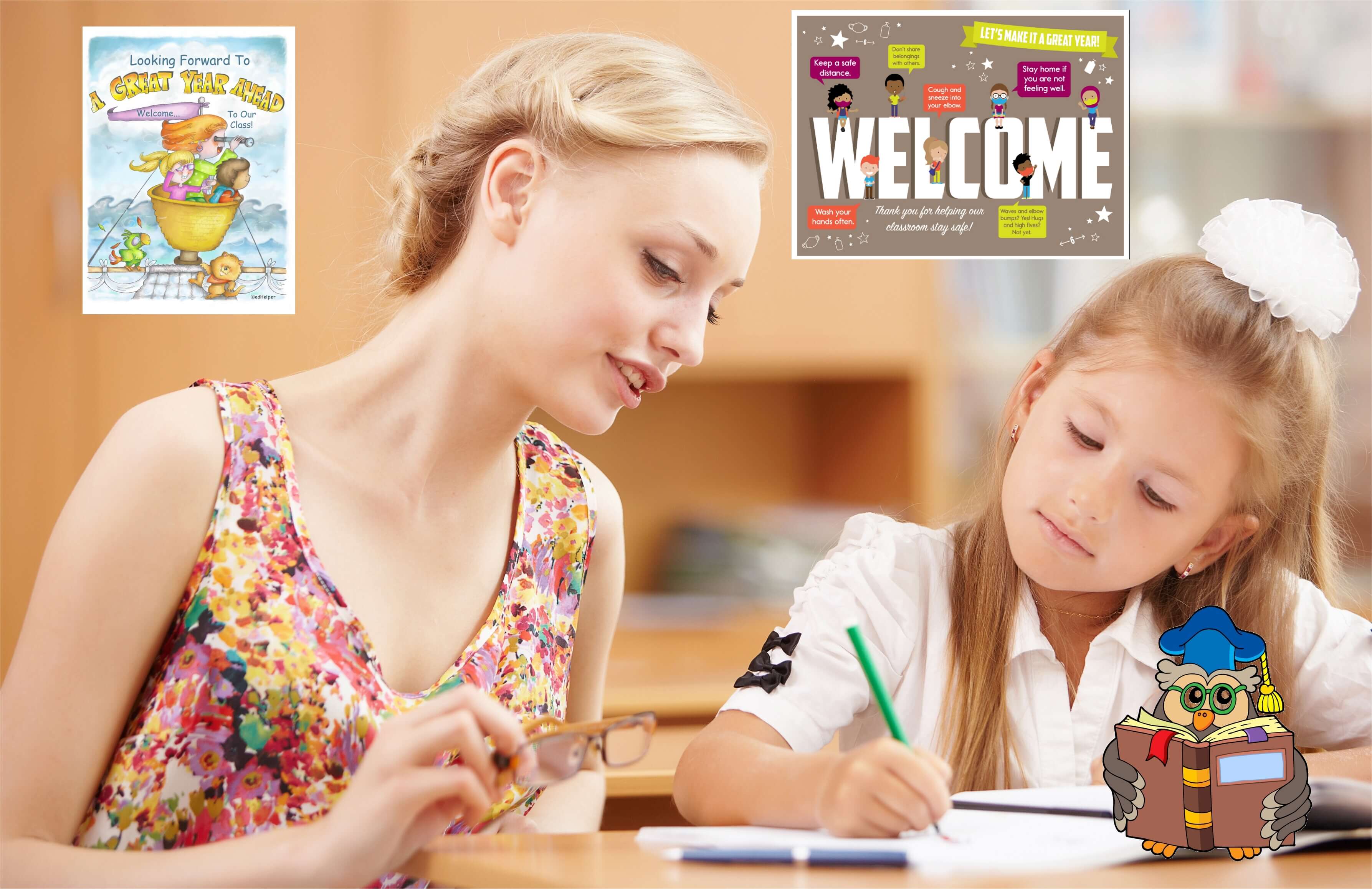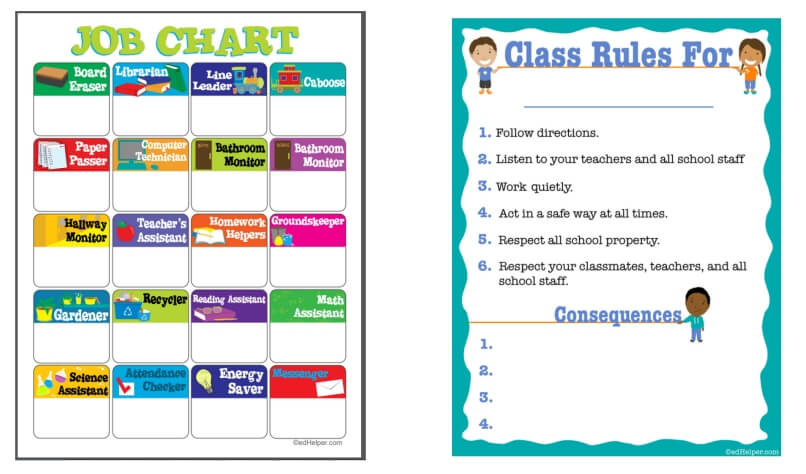Insights and Tips to Make Your First Year Teaching Second Grade the Best Ever
By: edHelper Staff
Updated: Aug 3, 2023

What makes teaching second graders unique?
Like Goldilocks, many teachers find second grade to be just right.
It's the last grade where students are overwhelmingly excited about going to school. Yet, they also have a few years of experience being students, which means they understand there are rules and routines they need to follow.
Second graders love to talk with others, including adults, and they have made leaps and bounds when it comes to their listening skills. Many second-grade teachers love having actual conversations with their students!
But second grade comes with plenty of challenges too. As is the case with any grade, it helps to be prepared, especially if you're teaching seven- and eight-year-olds for the first time.
Here's what to expect as a new second-grade teacher, along with plenty of tips to make sure your first year is a success.
Second Graders Are Ready For a Little More Responsibility
In second grade, students are able to handle more responsibilities than ever before. Beyond keeping classroom spaces clean, they can be entrusted with classroom jobs that teach them responsibility and support their need for greater independence. It means a little less work for you too!
For example, if you have a student who loves computers, make them a computer helper. If other students have trouble logging in or figuring out what buttons to push, they're the ones to ask.
Consider rotating weekly jobs on a bulletin board. You can include things like:
- Line leaderSecretary who answers the phone
- Classroom library organizer
- Pencil sharpener
- Lights on and off
- Paper passer
- Hand sanitizer helper
- Trash monitor
- Plant helper
This list is by no means complete! Think about some of the jobs you have to do on a daily basis and consider entrusting them to your students.
Decorate

Support Them in Becoming Role Models For Younger Students
Having a little bit more responsibility in second grade also means being a role model for younger students.
Remind your students that kindergartners and first graders are looking up to them. Remind them how to act outside the classroom. You can also consider working with kindergarten and first grade teachers on buddy activities that enable your second graders to practice what it means to be a leader.
Reminders Will Still Be Needed
You might expect kindergartners and first graders to need help getting in line, putting materials away, sharpening pencils, and quieting down ahead of the next lesson. But, in second grade, some teachers fall into the trap of thinking that their young students should have school routines all figured out.
The truth is, second graders will still need reminders.
Try not to get frustrated by your second graders and their behavior. Even though they have been in school for a few years, they may still walk out of line, forget to write their name on their worksheets, and forget to pick up after themselves. The good news is that most second graders just need a quick reminder to get back on track again.
You can make things easier by modeling the right behavior for your students. You should also take the time to review rules and procedures. This is especially true at the beginning of the year, but it might also be necessary after holiday breaks or even after a shakeup in their routine.
Start a Seatwork Routine
Second graders are really getting into their independence. They enjoy doing things on their own, and many second graders love showing you that they can do stuff on their own! That comes in handy for second-grade teachers because it means their students are capable of doing some seatwork.
Seatwork is a great way to start the day. As students enter the classroom, they put their stuff away, go to their desks, and work quietly until the day starts.
Seatwork can be effective after recess when students need a chance to calm down ahead of the next lesson. It can also be used when there's time to kill, and it can come in handy if a substitute has to cover your classroom.
Worksheets make the best seatwork activity. They can include academic work, like spiral math reviews, or they can contain fun activities like word finds and color by number.
Let Students Try Out Choice Time
Because second graders have an evolving sense of independence, they love the opportunity to exercise it! If you aren't afraid of a little chaos, and you're willing to do a lot of modeling and reminding, you should give choice time a try.
Students are allowed to choose their own free time activity during choice time. You can provide them with a list of options to make it easier. Students might choose between:
- Free readingDrawing and coloring
- Building with Legos or other materials
- iPad or computer games
- Math activity like sorting shapes
- Fine motor skill activity like making beaded bracelets
- Gross motor skill activity like hopping pretend river stones
It's important to set very clear rules ahead of time. For example, you might limit the number of students who are allowed to do each activity. You might make a sign to remind students that there is no running, no yelling, they have to stay at their table, and any other rules that work for your classroom. If some activities are more popular than others, like iPad games, you might create a schedule so everyone gets a turn.
Use Their Love of Facts and Order to Your Advantage
Second graders love facts. Teachers learn this quickly as it's always second graders who are more than happy to remind you of something you forgot!
They love order, too. They appreciate more than any other grade when they know exactly how the classroom library is organized, where they put things when they come into the classroom in the morning, and what is expected of them during work time.
Lean into their love of facts and order by creating a predictable, orderly classroom. Give them the responsibility of helping you remember things, and give them opportunities to keep things in the classroom nice and orderly.
Choose Math Homework That Allows Them to Focus on Facts
Because second graders love facts and order, they are much more concerned with the final product than the process. That's a stark change compared to first grade, when most students are more interested in the process.
Now more than in any other grade, your students are primed to memorize important math facts.
Give them repetitive math worksheets that enable them to add, subtract, and multiply. As they practice, they'll start to remember answers automatically without having to do the math.
Don't make the mistake of thinking that these kinds of worksheets are boring! There are many fun, engaging ways to present the same math facts so that students remain interested in learning.
Help Them Through Perfectionistic Tendencies
Thanks to second graders' love of facts and order, their classrooms can run like well-oiled machines, but that doesn't mean there aren't a few drawbacks.
A preoccupation with facts and order also comes along with perfectionistic tendencies. Second graders can find it difficult to cope if something doesn't go according to plan or if you mix up their routine.
They can be especially hard on themselves when they make a mistake. Because they're so focused on the end result, they expect the process to unfold in a certain way. If they mess up or can't find the answer, it's hard for them to shrug it off and try again.
It can be very helpful for teachers to demonstrate what it looks like to make mistakes and laugh them off. You can make a mistake on purpose and show them that you don't mind erasing your work and starting over.
Remind them that learning is in the process; it's not necessarily the result. Take deep breaths together, let them talk about their frustrations, and create a classroom environment where everyone cheers each other on to help students get past perfectionistic tendencies.
Create Clear Steps for Students to Follow in Open-Ended Assignments
Open-ended assignments, like drawing a self-portrait or writing a story, can be especially difficult for second graders. They focus so closely on the end result that breaking down an activity into steps by themselves becomes too overwhelming.
That doesn't mean you shouldn't give your second graders open-ended assignments! It just means you should help them through the assignments by clarifying each step.
Break down the assignment, and make each step in the process an end result on its own. That way, students don't feel overwhelmed. It also means they can slow down and give each step of the process the attention it deserves. In the end, they can see how a bunch of smaller steps can contribute to a better end result, which is a great lesson to learn.
The second grade is a magical time when students are still excited about school. They're more independent, interactive, and communicative too.
That makes teaching second graders a lot of fun, but that doesn't mean it doesn't come with its own challenges. Armed with the tips and insights on this list, you can work with your students' development instead of against it, making your first year of teaching something to treasure for a lifetime.
Second Grade Resources













